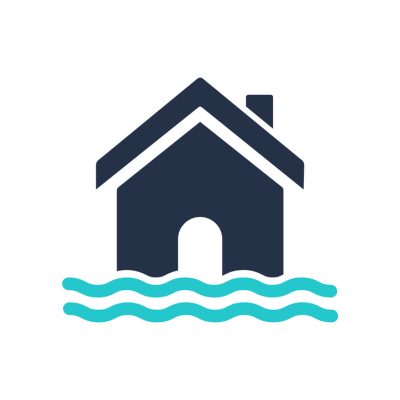Water Damage Remediation
WATER DAMAGE REMEDIATION

THE FIVE-STEP PROCESS FOR REMEDIATION
- Inspection and assessment
- Water removal
- Drying and dehumidification
- Cleaning and sanitizing
- Restoration and water damage repair
Does water damage need repair?
If you notice water damage to walls, carpet, wood, or other porous materials in your house, you will be required to remove and replace them. If you notice carpet or wood that will not require extensive water damage repair, you may be able to save certain areas by drying them out ASAP.
Does homeowners’ insurance policy cover water damage?
Your property insurance should include coverage for any sudden or accidental discharge of water in your home. This includes coverage for water line breaks or if any of your appliances overflow or leak. You should also be covered if hail or wind causes a hole in your home through which water enters and causes damage.
However, homeowners’ insurance typically does not cover damage due to ignored maintenance issues.
How much does it cost to restore water damage?
The average homeowner spends between $1,212 and $5,168 to restore or repair water damage, with an average of $3,190. A water damage repair professional can determine the cause and extent of the destruction by categorizing and classifying the damage to your home, which can be the two largest factors in figuring the final bill.
Here’s a TIP:
Want to avoid large cleanup and repair bills? Preventative maintenance and cleaning up quickly after damage are critical to keeping costs down. How long moisture is left untreated increases the scope of the damage and allows mold to grow. Preventing damage by contacting professionals to diagnose causes and make small repairs can save thousands later. Regardless of cause or cost, always document the damage for insurance claims.
Though a competent DIY homeowner may be able to clean up and repair some damage, it’s important to have a professional assess it first to determine the extent and any underlying conditions. Missing even a small amount, or its causes, can lead to costlier repairs later. Even small quantities of moisture may result in mold growth. Plus, undiagnosed causes will lead to recurrences. For instance, fixing a damaged ceiling but not the leaky roof that caused it will only lead to another wrecked ceiling.
Though a competent DIY homeowner may be able to clean up and repair some damage, it’s important to have a professional assess it first to determine the extent and any underlying conditions. Missing even a small amount, or its causes, can lead to costlier repairs later. Even small quantities of moisture may result in mold growth. Plus, undiagnosed causes will lead to recurrences. For instance, fixing a damaged ceiling but not the leaky roof that caused it will only lead to another wrecked ceiling.
Roof
Diagnosing a leaky roof is best left to professionals. Improperly repairing or installing a roof can lead to more issues. Sometimes, an insurance company may require a professional inspection. The most common causes of leaky roofs are:
- Missing shingles that often come off due to high winds
- Damaged flashing around pipes, chimneys, skylights, and in valleys
- Roofs with low slopes and inadequate runoff
Ceiling Repairs
Repairs to a ceiling cost between $350 and $2000 and are usually associated with a roof or pipe leak from above. If a pipe has broken in a ceiling, the cost for repairs can be within this range depending on the type of ceiling and extent of damage.
Basement Damage and Flooding
Moisture damage in your basement happens for a wide range of reasons including flooding, drainage issues, clogged gutters, burst pipes, and sewage backups. Repair costs vary widely depending on the cause and extent of the destruction.
For instance, it will be less expensive to restore a basement with an inch of clean water from a burst pipe than to tackle a fix caused by three feet of sewage backup. An inch of clean water would start at around $500 to $1500 to pump out and thoroughly dry it. However, the price of basement drainage repairs can increase $2,800 or more depending on the size of the space and the extent of the damage. Budget more when your space has been hit from contaminated sources, like a river flood.
For instance, it will be less expensive to restore a basement with an inch of clean water from a burst pipe than to tackle a fix caused by three feet of sewage backup. An inch of clean water would start at around $500 to $1500 to pump out and thoroughly dry it. However, the price of basement drainage repairs can increase $2,800 or more depending on the size of the space and the extent of the damage. Budget more when your space has been hit from contaminated sources, like a river flood.
Drywall
Drywall repair costs typical range from $300 to $850 but can cost much more or less depending on the destruction. It is used in most modern homes and is found in almost all finished areas of a house, including bathrooms. When it becomes wet, it typically needs to be replaced. Not only is the drywall itself ruined, but the wet paper backer of the drywall becomes an excellent environment for mold growth.
Floors and Hardwood
The type of flooring and the length of time water sits affects the costs of removal and repair. Some types of flooring are more permeable than others. For example, laminates and carpet soak up liquids and degrade the subfloor quickly, whereas hardwood can sit underwater for short periods with little damage. Most tile products are either impervious to liquids or can be cleaned and dried with little or no damage, though the area may need grout work.
Broken or Leaky Bathroom Fixtures
A faucet leak, cracked bathtub, or failing toilet can easily become a much larger and costlier problem. A 120-square foot bathroom can cost as much as $3,000 to clean up and repair. Whereas fixing a leaky faucet range from $150 to $350 when hiring a plumber but can save thousands in future expenses. More importantly, homeowner’s insurance typically does not cover damage due to ignored maintenance issues.
Burst Pipes and Leaky Plumbing
Among the most common and most preventable causes of water damage are burst pipes that can result in repairs costing $1,000 to $4,000. Burst pipes typically happen because of clogs and freezing. Prevent the damage by finding a family plumber to do annual inspections. Regular inspections and maintenance are a cost-effective, preventative measure. Installing new plumbing typically runs between $350 to $2,000 but can save thousands in future expenses.
Natural Causes
Inclement weather, such as flooding, are common natural causes, as are high water tables and improperly graded ground. Installing a sump pump is a sensible water damage prevention in areas with high water tables. The sump pump will pump water from under the foundation to drain it away from the home and averages about $1,200 to install. The sump pump itself will cost between $50 to $400. Also, ground that slopes towards the basement of the home can lead to leakage in the basement and increased stress on sewage systems.
